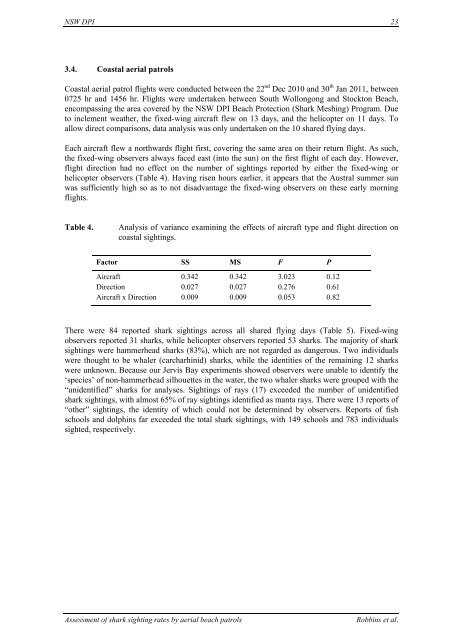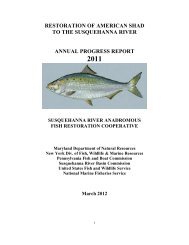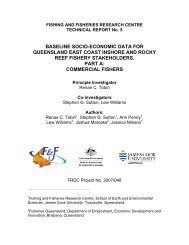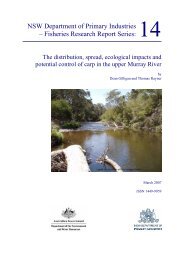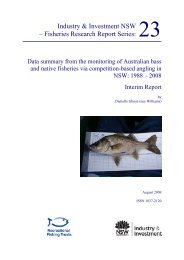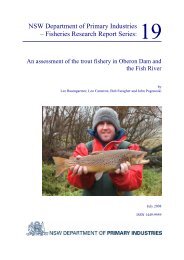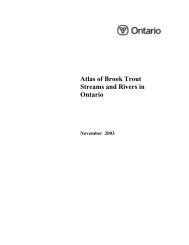Assessment of shark sighting rates by aerial ... - Fisheries Reports
Assessment of shark sighting rates by aerial ... - Fisheries Reports
Assessment of shark sighting rates by aerial ... - Fisheries Reports
Create successful ePaper yourself
Turn your PDF publications into a flip-book with our unique Google optimized e-Paper software.
NSW DPI 23<br />
3.4. Coastal <strong>aerial</strong> patrols<br />
Coastal <strong>aerial</strong> patrol flights were conducted between the 22 nd Dec 2010 and 30 th Jan 2011, between<br />
0725 hr and 1456 hr. Flights were undertaken between South Wollongong and Stockton Beach,<br />
encompassing the area covered <strong>by</strong> the NSW DPI Beach Protection (Shark Meshing) Program. Due<br />
to inclement weather, the fixed-wing aircraft flew on 13 days, and the helicopter on 11 days. To<br />
allow direct comparisons, data analysis was only undertaken on the 10 shared flying days.<br />
Each aircraft flew a northwards flight first, covering the same area on their return flight. As such,<br />
the fixed-wing observers always faced east (into the sun) on the first flight <strong>of</strong> each day. However,<br />
flight direction had no effect on the number <strong>of</strong> <strong>sighting</strong>s reported <strong>by</strong> either the fixed-wing or<br />
helicopter observers (Table 4). Having risen hours earlier, it appears that the Austral summer sun<br />
was sufficiently high so as to not disadvantage the fixed-wing observers on these early morning<br />
flights.<br />
Table 4. Analysis <strong>of</strong> variance examining the effects <strong>of</strong> aircraft type and flight direction on<br />
coastal <strong>sighting</strong>s.<br />
Factor SS MS F P<br />
Aircraft 0.342 0.342 3.023 0.12<br />
Direction 0.027 0.027 0.276 0.61<br />
Aircraft x Direction 0.009 0.009 0.053 0.82<br />
There were 84 reported <strong>shark</strong> <strong>sighting</strong>s across all shared flying days (Table 5). Fixed-wing<br />
observers reported 31 <strong>shark</strong>s, while helicopter observers reported 53 <strong>shark</strong>s. The majority <strong>of</strong> <strong>shark</strong><br />
<strong>sighting</strong>s were hammerhead <strong>shark</strong>s (83%), which are not regarded as dangerous. Two individuals<br />
were thought to be whaler (carcharhinid) <strong>shark</strong>s, while the identities <strong>of</strong> the remaining 12 <strong>shark</strong>s<br />
were unknown. Because our Jervis Bay experiments showed observers were unable to identify the<br />
‘species’ <strong>of</strong> non-hammerhead silhouettes in the water, the two whaler <strong>shark</strong>s were grouped with the<br />
“unidentified” <strong>shark</strong>s for analyses. Sightings <strong>of</strong> rays (17) exceeded the number <strong>of</strong> unidentified<br />
<strong>shark</strong> <strong>sighting</strong>s, with almost 65% <strong>of</strong> ray <strong>sighting</strong>s identified as manta rays. There were 13 reports <strong>of</strong><br />
“other” <strong>sighting</strong>s, the identity <strong>of</strong> which could not be determined <strong>by</strong> observers. <strong>Reports</strong> <strong>of</strong> fish<br />
schools and dolphins far exceeded the total <strong>shark</strong> <strong>sighting</strong>s, with 149 schools and 783 individuals<br />
sighted, respectively.<br />
<strong>Assessment</strong> <strong>of</strong> <strong>shark</strong> <strong>sighting</strong> <strong>rates</strong> <strong>by</strong> <strong>aerial</strong> beach patrols Robbins et al.


